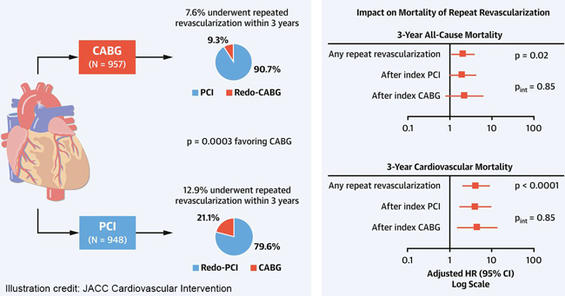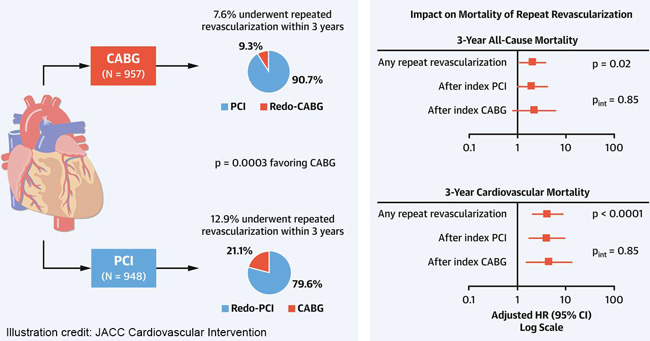Mortality after repeat revascularization following PCI or coronary artery bypass grafting for left main disease: The EXCEL Trial
Selected in JACC: Cardiovascular Interventions by M. Alasnag , K. Al-Shaibi
This study is a sub-analysis of the EXCEL (Evaluation of XIENCE Versus Coronary Artery Bypass Surgery for Effectiveness of Left Main Revascularization) trial. Its aim is to evaluate the rate and impact of repeat revascularization of the Left Main coronary artery using modern PCI or surgical techniques.
References
Authors
Giustino G, Serruys PW, Sabik JF 3rd, Mehran R, Maehara A, Puskas JD, Simonton CA, Lembo NJ, Kandzari DE, Morice MC, Taggart DP, Gershlick AH, Ragosta M 3rd, Kron IL, Liu Y, Zhang Z, McAndrew T, Dressler O, Généreux P, Ben-Yehuda O, Pocock SJ, Kappetein AP, Stone GW
Reference
JACC Cardiovasc Interv. 2020 Jan 10 [Epub ahead of print]
Published
January 2020
Link
Read the abstractReviewers
Our Comment
Why this study – the rationale/objective?
Refinements in percutaneous revascularization (PCI) techniques and stent platforms, surgical techniques and medical therapy have all contributed to a lower major adverse cardiac event rate (MACE), namely death, stroke, or myocardial infarction (MI). Much of the focus of large randomized trials revolves around MACE. The impact of repeat revascularizations on hospitalizations, quality of life and overall mortality remains largely underexplored and underemphasized in trials.
This study is a sub-analysis of the EXCEL (Evaluation of XIENCE Versus Coronary Artery Bypass Surgery for Effectiveness of Left Main Revascularization) trial. Its aim is to evaluate the rate and impact of repeat revascularization of the Left Main coronary artery (LM) using modern PCI or surgical techniques.
How was it executed – the methodology?
The EXCEL trial was an open-label, multicenter, randomized trial comparing PCI using cobalt-chromium fluoropolymer based everolimus-eluting stents (XIENCE; Abbott Vascular, Santa Clara, California) to CABG in patients with LM disease > 70% by visual estimation or 50% by ischemia-driven revascularization at 3 years. This is a secondary analysis from the EXCEL trial that recorded the incidence, risk factors, and prognostic impact of repeat revascularization (ischemia-driven, non-ischemia driven, target lesion revascularization (TLR), target vessel revascularization (TVR), target-vessel non-TLR, non-TVR, repeat revascularization with PCI, and repeat revascularization with CABG. The impact of each of these revascularization events on all-cause, cardiovascular, and non-cardiovascular mortality at 3-year follow-up were assessed.
What is the main result?

Giustino, G. et al. J Am Coll Cardiol Intv. 2020;13(3):375-87
Patients assigned to PCI had higher rates of any repeat revascularization compared to CABG (12.9% vs. 7.6%) at 3 years. There were no significant differences in the rates of repeat revascularization between PCI and CABG at 6 months (3.1% vs. 3.2%) with the differences arising primarily after 6 months.
In the PCI arm, stent thrombosis accounted for the repeat revascularization in 8 of 117 patients (7.1%). In the CABG arm, symptomatic graft occlusion accounted for revascularizations in 42 of 68 patients (62.7%). Overall, repeat revascularization was performed through PCI in both arms. Repeat revascularization with CABG was performed more frequently in those initially randomized to PCI compared with CABG (3.3% vs. 0.8%).
Predictors of repeat revascularization included a higher body mass index, insulin-treated diabetes, and hemodynamic support during the index procedure. Young age, female sex, and peripheral vascular disease were independent predictors of repeat revascularization after CABG. Statin use was protective in both arms.
With respect to mortality at 3 years, there were 128 all-cause, 74 cardiovascular and 54 non-cardiovascular deaths. Repeat revascularization was independently associated with an increased all-cause mortality and cardiovascular mortality but not non-cardiovascular mortality both in the PCI and CABG arms. The association of repeat revascularization with MI or stroke was smaller (adjusted HR: 16.62; 95% CI: 9.97 to 27.69; p < 0.0001). The risk for mortality after repeat revascularization peaked within 30 days and subsequently declined. Expectedly, TVR and TLR were both associated with an increased mortality; however, target vessel non–target lesion revascularization and non–target vessel revascularization were not.
Critical reading and the relevance for clinical practice
Although the PCI arm had more repeat revascularizations, the majority had less severe angina. Those who had undergone CABG, were less likely to undergo a repeat procedure which may be attributed to a higher threshold for repeat revascularization post-CABG and/or anatomical factors that render a repeat procedure unsuitable or higher risk. It is not surprising that whenever revascularization was deemed necessary, PCI was employed in the majority of cases including those initially treated by CABG.
Compared to the SYNTAX trial LM subset, the rate of target lesion revascularization (TLR) was lower in EXCEL. Whether that is due to refinement in the stent technology (Paclitaxel vs Everolimus), more potent antiplatelet regimens or a result of adopting better PCI techniques like image-guided optimization remains speculative. On further analysis, the overall health status, quality of life, and freedom from angina at 3 years were similar in both studies.
Mortality following TLR in this study was higher than that observed in other meta-analyses of non-LM revascularization suggesting a larger area of myocardium at jeopardy in LM revascularization compared to non-LM studies. The attenuation of the mortality rate after 30 days suggests risks integral to the revascularization itself and not patient factors especially since the baseline SYNTAX score did not differ between the two arms.
This trial is thought-provoking. The fact that repeat revascularization occurs more frequently after LM PCI than it does following CABG, further emphasizes that although not included in the composite primary endpoint of EXCEL repeat revascularization is not necessarily a benign phenomenon in LM percutaneous intervention.
This sobering data should act as a catalyst for the interventional community at large (both industry and physicians). Industry should continue to refine drug-eluting stent platforms. Physicians offering PCI as an alternative to CABG for patients with LM disease should be more diligent in incorporating best practices in their LM PCI procedures including intracoronary imaging, physiology and optimal bifurcation techniques.
Once again, the heart team decision is paramount in determining the most appropriate repeat revascularization strategy. This should be discussed frankly using local outcome data for LM PCI and CABG from each center and operator. As studies have shown operator volume and experience also effect outcomes of both PCI and CABG.







No comments yet!